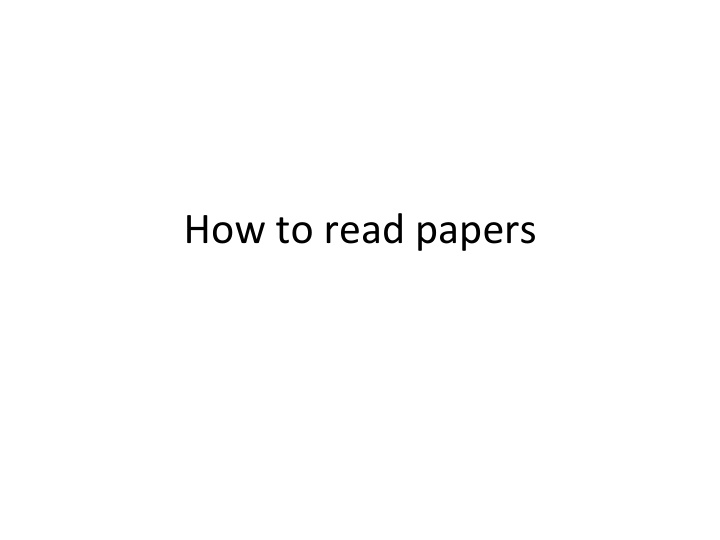



How ¡to ¡read ¡papers ¡
What ¡is ¡a ¡scien1fic ¡paper? ¡ • Scien1sts ¡communicate ¡their ¡research ¡findings ¡ by ¡wri1ng ¡papers. ¡ • Papers ¡(in ¡CS) ¡are ¡usually ¡published ¡in: ¡ – Journals: ¡periodicals ¡on ¡a ¡par1cular ¡subarea ¡of ¡CS ¡ – Conference ¡proceedings: ¡a ¡collec1on ¡of ¡papers ¡ presented ¡at ¡a ¡mee1ng ¡of ¡people ¡in ¡a ¡subarea. ¡ • Peer ¡review ¡ – Papers ¡are ¡veDed ¡by ¡experts ¡in ¡your ¡subarea ¡ before ¡publica1on. ¡
Why ¡bother ¡reading ¡papers? ¡ • All ¡the ¡newest ¡research ¡is ¡in ¡papers. ¡ – You'll ¡learn ¡what's ¡been ¡figured ¡out ¡and ¡what's ¡leI ¡to ¡ discover. ¡ • Papers ¡oIen ¡suggest ¡new ¡avenues ¡of ¡research ¡ ("future ¡work"). ¡ • Contain ¡informa1on ¡about ¡how ¡experiments ¡ were ¡conducted, ¡methodology ¡used, ¡tools ¡and ¡ equipment ¡needed. ¡ – Can ¡give ¡you ¡ideas ¡on ¡how ¡to ¡conduct ¡your ¡own ¡ research. ¡
Two ¡types ¡of ¡papers ¡ • Primary ¡research ¡paper ¡ ¡ – These ¡are ¡the ¡"new ¡findings" ¡in ¡research. ¡ – Contain ¡ original ¡data, ¡experiments, ¡discoveries, ¡ findings, ¡conclusions. ¡ – (Hopefully) ¡should ¡contain ¡enough ¡informa1on ¡to ¡ ¡ • verify ¡the ¡authors' ¡claims ¡ • replicate ¡the ¡findings ¡ ¡
Two ¡types ¡of ¡papers ¡ • Review ¡paper ¡ – Give ¡an ¡overview ¡of ¡a ¡subarea. ¡ – Summarize ¡many ¡different ¡papers. ¡ – OIen ¡contain ¡more ¡background ¡informa1on ¡than ¡ primary ¡research ¡ar1cles. ¡ ¡
Sec1ons ¡of ¡a ¡primary ¡research ¡paper ¡ • Abstract ¡ – Summary ¡highligh1ng ¡the ¡main ¡research ¡ ques1ons, ¡provides ¡key ¡results ¡of ¡experiments, ¡ and ¡usually ¡some ¡short ¡conclusions. ¡ – Read ¡to ¡figure ¡out ¡if ¡the ¡whole ¡paper ¡is ¡worth ¡ reading. ¡ – If ¡the ¡ar1cle ¡is ¡behind ¡a ¡paywall, ¡the ¡abstracts ¡are ¡ usually ¡free. ¡
Sec1ons ¡of ¡a ¡primary ¡research ¡paper ¡ • Introduc1on ¡ – Gives ¡background ¡informa1on ¡and ¡introduces ¡the ¡ research ¡ques1ons ¡to ¡be ¡studied. ¡ – Usually ¡includes ¡lots ¡of ¡cita1ons ¡to ¡other ¡ar1cles ¡ in ¡order ¡to ¡posi1on ¡the ¡new ¡research ¡in ¡the ¡field. ¡ – OIen ¡includes ¡mo1va1on ¡for ¡why ¡this ¡research ¡is ¡ important. ¡ – If ¡intro ¡makes ¡no ¡sense, ¡rest ¡of ¡the ¡ar1cle ¡may ¡not ¡ either. ¡ ¡Consult ¡a ¡review ¡paper, ¡textbook, ¡or ¡ cita1ons ¡in ¡the ¡paper. ¡
Sec1ons ¡of ¡a ¡primary ¡research ¡paper ¡ • "Materials ¡and ¡Methods" ¡ – Rarely ¡called ¡that. ¡ – One ¡or ¡more ¡sec1ons ¡that ¡illustrate ¡what ¡the ¡ researchers ¡did. ¡ • Created ¡a ¡new ¡algorithm? ¡ ¡Give ¡the ¡algorithm. ¡ • Ran ¡experiments? ¡ ¡Explain ¡them. ¡ • Results ¡ – "Did ¡it ¡work?" ¡ – OIen ¡numerical ¡data ¡from ¡experiments. ¡ – OIen ¡includes ¡charts ¡and ¡graphs. ¡
Sec1ons ¡of ¡a ¡primary ¡research ¡paper ¡ • Evalua1on ¡ – If ¡there's ¡a ¡new ¡system/algorithm/technique, ¡how ¡ well ¡does ¡it ¡perform? ¡ – Are ¡these ¡results ¡significant ¡compared ¡to ¡other ¡ results? ¡ • Discussion ¡and ¡conclusions ¡ – Opinions ¡about ¡what ¡the ¡research ¡means, ¡how ¡it ¡can ¡ be ¡used, ¡further ¡hypotheses ¡or ¡experiments ¡to ¡run, ¡ future ¡work. ¡ – Stuff ¡here ¡is ¡author's ¡interpreta1ons, ¡not ¡necessarily ¡ factual. ¡ • References ¡
How ¡to ¡read ¡it: ¡two ¡passes ¡ • First ¡pass: ¡ – Read ¡1tle, ¡abstract, ¡introduc1on. ¡ ¡Skim ¡heart ¡of ¡the ¡paper. ¡ ¡ Read ¡conclusions. ¡ – Goal: ¡be ¡able ¡to ¡state ¡the ¡research ¡ques1on ¡and ¡major ¡ conclusions. ¡ • Might ¡stop ¡here ¡ • Second ¡pass: ¡ – Read ¡everything ¡more ¡carefully. ¡ – Only ¡skim ¡technical ¡details ¡like ¡proofs. ¡ – Pay ¡special ¡aDen1on ¡to ¡figures, ¡graphs, ¡and ¡charts. ¡ – Goal: ¡be ¡able ¡to ¡summarize ¡to ¡another ¡person ¡the ¡content ¡ of ¡the ¡paper. ¡
Recommend
More recommend